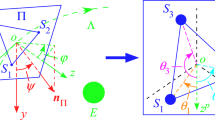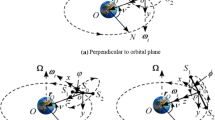Abstract
A relative motion model for a satellite formation composed of two Earth-orbiting spacecraft located in the geostationary ring is developed taking into account major gravitational and non-gravitational forces. A previously existing model featuring perturbation due to \(J_2\) is enhanced by the perturbations due to solar radiation pressure arising from unequal area-to-mass ratios, as well as the secular and long-periodic gravitational perturbations due to the Sun and the Moon. The extended relative motion model is validated using several typical formation geometries against a reference generated by numerical integration of the absolute orbits of the two spacecraft. The results of this work can find application in future on-orbit servicing and formation flying missions in near-geostationary orbit.



Similar content being viewed by others
References
Aksnes, K.: Short-period and long-period perturbations of a spherical satellite due to direct solar radiation. Celest. Mech. 13, 89–104 (1976)
Ardaens, J.-S., D’Amico, S., Fischer, D.: Early flight results from the TanDEM-X autonomous formation flying system. In: 4th International Conference on Spacecraft Formation Flying Missions and Technologies (SFFMT), St-Hubert, Quebec (2011)
Ardaens, J.-S., Kahle, R., Schulze, D.: In-flight performance validation of the TanDEM-X autonomous formation flying system. In: 5th International Conference on Spacecraft Formation Flying Missions and Technologies (SFFMT), Munich, Germany (2013)
Bryant, R. W.: The effect of solar radiation pressure on the motion of an artificial satellite. NASA Technical Note D-1063 (1961)
Caswell, D. et al.: ConeXpress orbital life extension vehicle—a commercial service for communications satellites. ESA Bull. 127, 54–61 (2006)
Clohessy, W.H., Wiltshire, R.S.: Terminal guidance system for satellite rendezvous. J. Aerosp. Sci. 27(9), 653–658 (1960)
D’Amico, S.: Autonomous formation flying in low-Earth orbit, PhD Thesis, Technical University of Delft (2010)
D’Amico, S., Ardaens, J.-S., Larsson, R.: Spaceborne autonomous formation-flying experiment on the PRISMA mission. J. Guid. Control Dyn. 35(3), 834–850 (2012)
D’Amico, S., Ardaens, J.-S., Gaias, G., Benninghoff, H., Schlepp, B., Jørgensen, J.L.: Noncooperative rendezvous using angles-only optical navigation: system design and flight results. J. Guid. Control Dyn. 36(6), 1576–1595 (2013)
Eckstein, M. C., Rajasingh, C. K., and Blumer, P.: Colocation strategy and collision avoidance for the geostationary satellites at 19 degrees West. In: CNES International Symposium on Space Dynamics (1989)
Gaias, G., D’Amico, S., Ardaens, J.-S.: Angles-only navigation to a noncooperative satellite using relative orbital elements. J. Guid. Control Dyn. 37(2), 439–451 (2014)
Gaias, G., Ardaens, J.-S., D’Amico, S.: The autonomous vision approach navigation and target identification (AVANTI) experiment: objectives and design. In: 9th International ESA Conference on Guidance, Navigation & Control Systems, Porto, Portugal (2014)
Gaias, G., Ardaens, J.-S., Montenbruck, O.: Model of \(J_2\) perturbed relative motion with time-varying differential drag. Celest. Mech. Dyn. Astron. 123(4), 411–433 (2015)
Giacaglia, G.E.O.: Lunar perturbations of artificial satellites of the Earth. Celest. Mech. 9, 239–267 (1974)
Härting, A., Rajasingh, C.K., Eckstein, M.C., Leibold, A.F., and Srinivasamurthy, K.N.: On the collision hazard of colocated geostationary satellites. AIAA/AAS Astrodyn. Conf. AIAA Pap., 1988–4239 (1988)
Kaiser, C., Sjöberg, F., Delcura, J.M., Eilertsen, B.: SMART-OLEV–an orbital life extension vehicle for servicing commercial spacecrafts in GEO. Acta Astronaut. 63(1–4), 400–410 (2008)
Kaula, W.M.: Development of the lunar and solar disturbing functions for a close satellite. Astronom. J. 67, 300–303 (1962)
Kozai, Y.: Effects of solar radiation pressure on the motion of an artificial satellite. Smithson. Contrib. Astrophys. 6, 109 (1963)
Kozai, Y.: A new method to compute lunisolar perturbations in satellite motions. Smithsonian Astrophysical Observatory Special Report 349 (1973)
Montenbruck, O., Gill, E.: Satellite Orbits: Models Methods and Applications. Springer, Heidelberg (2000)
Montenbruck, O., Kirschner, M., D’Amico, S., Bettadpur, S.: E/I-vector separation for safe switching of the GRACE formation. Aerosp. Sci. Technol. 10(7), 628–635 (2006)
Prado, A.F.B.A.: Third-body perturbation in orbits around natural satellites. J. Guid. Control Dyn. 26, 33–40 (2003)
Roscoe, C.W.R., Vadali, S.R., Alfriend, K.T.: Third-body perturbation effects on satellite formations. Adv. Astronaut. Sci. 147, 483–502 (2013)
Ustinov, B.A.: Motion of satellites along low-eccentricity orbits in a noncentral terrestrial gravitational field. Cosm. Res. 5, 159 (1967)
Wnuk, E., Golebiewska, J.: The relative motion of Earth orbiting satellites. Celest. Mech. Dyn. Astron. 91, 373–389 (2005)
Acknowledgments
The author is grateful to Dr. R. Kahle for the many helpful discussions, as well as to Dr. G. Gaias for the valuable suggestions that improved the quality of the paper. The author also thanks the anonymous reviewers for the careful reading of the paper and insightful comments.
Author information
Authors and Affiliations
Corresponding author
Electronic supplementary material
Below is the link to the electronic supplementary material.
Rights and permissions
About this article
Cite this article
Spiridonova, S. Formation dynamics in geostationary ring. Celest Mech Dyn Astr 125, 485–500 (2016). https://doi.org/10.1007/s10569-016-9693-0
Received:
Revised:
Accepted:
Published:
Issue Date:
DOI: https://doi.org/10.1007/s10569-016-9693-0




